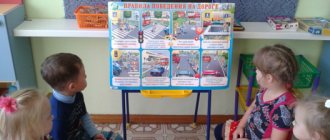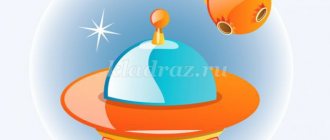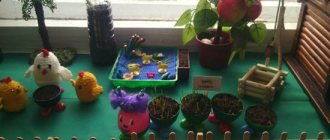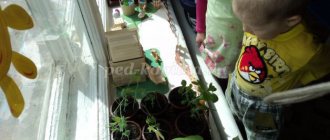Summer health campaign program for 2nd junior group
"SUMMER, AH, SUMMER!"
PROGRAM FOR ORGANIZING SUMMER RECREATION AND HEALTH IMPROVEMENT
PRESCHOOL CHILDREN
(2nd junior group)
The big summer break is given to preschoolers to strengthen their health, strengthen their physical condition, and restore strength after a long northern winter. This is a time for their enrichment, a time for action, testing and testing their strengths, a time for mastering and understanding the world around them.
Explanatory note
Summer is an amazing time! And every child looks forward to this wonderful time coming. For children, summer is a special period when they can have fun, get stronger, and grow up. Being in contact with nature, the child really gets to know the world, its sounds, colors, and receives vivid impressions that leave a mark on the child’s soul for life.
The big summer break is given to preschoolers to strengthen their health, strengthen their physical condition, and restore strength after a long northern winter. This is a time for their enrichment, a time for action, testing and testing their strengths, a time for mastering and understanding the world around them. The constant presence of children in the fresh air, the variety of shapes, colors and sounds in nature, many different experiences and new impressions, food rich in vitamins, freedom to move in natural conditions - all this gives the child a significant physical and emotional reserve of strength for successful full development and improvement. immunity.
Summer is fraught with some dangers for children's health - the risk of overheating, sunburn, general relaxation on hot days, fatigue from excessive running, the adverse effects of water when used excessively.
Due to the fact that in the summer the number of direct educational activities decreases, the daily routine is maximally saturated with outdoor activities: walks, excursions, hikes, games in nature - allow children to acquire new motor experience.
The work carried out in the summer has its own characteristics, although it is a continuation of the work carried out during the academic year.
Reasons for developing the program
- Law of the Russian Federation “On Education”
- Convention on the Rights of the Child
- Hygienic requirements for the design, maintenance and organization of the regime in health institutions with daytime stay for children during the holidays. Sanitary and epidemiological rules SP 2.4.4.969-00.
- Federal Law of July 24. 1998 “On the basic guarantees of the rights of the child in the Russian Federation.”
- Kindergarten program in the summer.
Target
- Creating conditions for organized recreation for children in the summer, development of the child’s personality, strengthening the physical, mental and emotional health of children, nurturing the best traits of a citizen.
Tasks for the summer wellness period:
- Creating comfortable conditions for the physical, mental, mental, artistic and aesthetic development of each child;
- Organization of a health-preserving regime, prevention of morbidity and injury;
- Providing the educational process with appropriate materials and equipment.
- Increasing the competence of parents in matters of raising and improving the health of children in the summer;
- Forming a positive attitude of parents and involving them in participation in this activity.
Long-term work plan for the summer period in the second junior group
JUNE
| №p/p | Activities | 1 Week | 2 week | 3 week | 4 week | |||
| Subjects | Dreamland | Letters | Weather on planet EARTH | Zoo | ||||
| Morning exercise complex | Complex No. 1 | Complex No. 1 | Complex No. 1 | Complex No. 2 | ||||
| Work | Cleaning the area of small debris: paper, pebbles, sticks. | Sweep the sand from the paths. | Invite the children to dig up sand in the sandbox. | Watering the garden. Cleaning the area from paper, pebbles, sticks. | ||||
| Goal: to teach children to work in a team, to cultivate hard work. Teach to see the benefits of your work (it became clean, beautiful; the plants will grow - watered) | ||||||||
| Individual work on PHYS while walking. |
|
|
|
| ||||
| Independent games for children. | Games with external materials: spatulas, scoops . | Offer children reins, jump ropes, and balls. | Independent games for children with dolls, dishes, cars. | Children's games in the sandbox with external materials: scoops, etc. | ||||
| Goal: to teach children to organize independent games. Share toys with children. Cultivate a friendly attitude towards each other during games. | ||||||||
| Outdoor games. |
|
|
|
| ||||
| Role-playing games | Goal: to continue the formation of role interaction: to orient the child’s role behavior towards a peer partner, to highlight the need to designate game roles in joint play. Role-playing games: “Hospital”, “Shop”, “Chauffeur”, “Family” | |||||||
| Didactic games |
|
|
|
| ||||
| Construction games. | Construction of roads and bridges (based on the model), airplanes, cars. Build together with the teacher: fences for animals, fences. | |||||||
| Games with sand and water. | Continue to introduce children to the properties of water (water can shimmer, bubble, murmur, be light, transparent or cloudy, colored) | |||||||
| Games of the peoples of the North. | Goal: to introduce children to the traditions of the inhabitants of the Urals. P/ games “Stop, deer!”, “Streams and lakes” | |||||||
| Round dance games | “Blow up the bubble”, “Cap”, “On a smooth path”, “Carousel”. Goal: to practice coordinating actions with words, to follow rules, to activate the vocabulary. | |||||||
| Upbringing cultural and hygienic standards. |
|
|
|
| ||||
| Independent artistic activity. |
|
|
|
| ||||
| Fiction |
|
|
(p. 53 HR.)
|
| ||||
| Labor activity |
|
|
|
| ||||
| Entertainment | Educator. Entertainment. Topic: “Hello red summer.” Goal: to give children the joy of meeting the heroes of the holiday. | Educator. Leisure. "At a forest crossroads" (page 35 “Three traffic lights”) Goal: to clarify and consolidate children’s knowledge about traffic rules on the street. | ||||||
| Job with parents | Consultation for parents. Topic: “On the benefits of natural factors (sun, air, water) on the child’s body” | Individual conversations with parents. Topic: “Child’s clothes for a walk” | Invite parents to improve the area: repair the sandbox, add sand, dig in benches. | Consultation for parents. Topic: “Outdoor games with children” | ||||
| Work on life safety, traffic rules, safety regulations | Look at the illustrations of A. Usachev’s book “Safety School” with your children. Learn the rule: “Don’t play around with matches and lighters. This is the cause of fires." | Excursion with children to the crossroads. Tell the children that they need to cross the street only in a certain place (intersection - traffic light, pedestrian crossing). | Read the works of S. Marshak “Fire” to the children. Goal: reinforce fire safety rules. | Transport surveillance. Goal: to develop children’s understanding of traffic rules. Reading the work of E. Mashkovskaya “I am a machine.” | ||||
JULY
| №p/p | Activities | 1 Week | 2 week | 3 week | 4 week | ||
| Subjects | Researchers familiar world | Motherland | Singing friends | Flower round dance | |||
| Morning exercise complex | Complex No. 1 | Complex No. 1 | Complex No. 2 | Complex No. 2 | |||
| Walk. Observation. | Observation of sand: how after rain it quickly absorbs water. | Observation of birch trees. Examine the green leaves: they are very tender and small. | Watching sparrows. Pay attention to how they swim in the puddles left after the rain. | Looking at marigolds. Flower structure: there is a green stem and a yellow flower. | |||
| Work | Loosen the sand in the kindergarten area, water it with water, and clear it of debris. | Teach children to care for trees. Tie up the broken branches and whiten the birch tree trunk. | Feed the sparrows the crumbs left over from breakfast. | Transplanting plants from soil to pot. | |||
| Individual work on PHYS while walking. | Throwing a ball up and catching it with both hands. | Improving the ability to climb inclined stairs. | Climbing under the arch without touching the floor with your hands. | Jumping on two legs while moving forward. | |||
| Independent games for children. | Drawing “summer” in the creativity corner. Goal: to help children express their emotional attitude towards summer. | Paper crafts (origami) with the help of a teacher. | Drawing bird figures on the asphalt with crayons. | Drawing flowers on the sand with pencils. | |||
| Outdoor games. | "Step over the stream" "Catch-up" | "Reach for the leaf" "Run to the Tree" | "Sparrows and the car" "The Mother Hen and the Chicks" | "Run to the flower" "Into the forest for flowers" | |||
| Role-playing games | “I bake pies and gingerbread cookies.” | "Journey to the Land of Green Giants" | "Zoo" | "Flower shop" | |||
| Goal: to continue the formation of role-playing interaction: to highlight the need for game roles in joint play, to stimulate role-playing dialogue. | |||||||
| Didactic games | "Fold the pattern" "Let's build a turret" | "Guests", “Let’s arrange a room for the doll” | "Birds at the Feeders" "Who's screaming" | "Plant a vegetable garden" "Teddy bear in the clearing" | |||
| Construction games. | Introduce the properties of sand: dry, wet. | Consideration of building plans for the city of Noyabrsk. | Making bird feeders. | Fencing flower beds. | |||
| Games with sand and water. | Strengthen the properties of water (shimmers, bubbles, murmurs) | Modeling from raw sand using molds. | Continue to get acquainted with the properties of sand (pass through a funnel). | Objects are washed, allowed to float, and water is poured. | |||
| Games of the peoples of the Urals. | "Have time to catch" p.110 Keneman | "The Clever Fisherman" p.109 | "Partridge and Hunters" p.100 | "Heiro" p.99 Keneman | |||
| Round dance games | “We won’t tell you where we were, but we’ll show you what we did.” Page 77 Bondarenko | "Loaf" p.83 Bondarenko | "Carousel" p.84 Bondarenko | "On a smooth path" | |||
| Purpose: to practice coordinating actions with words; activation of vocabulary, movements. | |||||||
| Upbringing cultural and hygienic standards. |
|
|
|
| |||
| Independent artistic activity. | Solving various riddles about the natural world. Develop research activities in children. Use an album with riddles. | Examination of the album, illustrations about the city of Noyabrsk. | Drawing figures of singing friends using stencils. | Looking at sets of postcards with images of flowers. | |||
| Fiction |
|
|
|
| |||
| Labor activity |
|
|
|
| |||
| Entertainment | Educator. Dramatization based on the works of A. Barto and P. Barto “The Dirty Girl” Purpose: recall. Desired. be clean. | Displaying pictures on flannelgraph. Goal: consolidate the names of colors. Development of children's aesthetic senses. | |||||
| Job with parents |
|
| Consultation “On the prevention of childhood injuries” |
| |||
| Work on life safety, traffic rules, safety regulations | Look at the illustrations of A. Usachev’s book “Safety School” with your children. Learn the rule: “Don’t play around with matches and lighters. This is the cause of fires." | Excursion with children to the crossroads. Tell the children that they need to cross the street only in a certain place (intersection - traffic light, pedestrian crossing). | Read the works of S. Marshak “Fire” to the children. Goal: reinforce fire safety rules. | Transport surveillance. Goal: to develop children’s understanding of traffic rules. Reading the work of E. Mashkovskaya “I am a machine.” | |||
AUGUST
| №p/p | Activities | 1 Week | 2 week | 3 week | 4 week |
| Subjects | Ecological fairy tale | Summer pharmacy | Sports summer | We grow crops and summer gatherings. | |
| Morning exercise complex | Complex No. 1 | Complex No. 2 | Complex No. 3 | Complex No. 4 | |
| Walk. Observation. | Observing the life of ants. Find out their habits. | Watching daisies. Find out why these flowers are good for your health. | Supervision of older children. How they know how to compete and follow the rules. | Observation and examination of vegetables grown in the garden. | |
| Work | Creating an ant farm. Fencing an anthill. Attaching a sign stating why ants should not be killed. | Collecting chamomile flowers to make a herbarium and create a green pharmacy in the group. | Paint the walking wheels. | Dig up the garden and prepare the soil for next year. | |
| Individual work on PHYS while walking. | Improve walking skills on a limited plane. | Drawing round objects | Working on the pronunciation of hissing sounds. | Walk along the cord, placing your heel to your toe. | |
| Independent games for children. | Construction of ecological pyramids and chains from sand. | Drawing familiar plants with colored crayons. | Cutting out medals for competitions. | Modeling vegetables and fruits from sand and clay. | |
| Outdoor games. | “Geese-geese” coordination of actions and text; “Shaggy Dog”, “Catch a Mosquito”, “Mice in the Pantry”. | “Run to the tree” – run; “Through the stream” - jumping; "Find the same one" | “Sparrows and the cat” - running; “On a level path” - jumping; “Guess where it’s hidden” - orientation in space. | “Quickly in a circle” - actions according to the rules; “Don’t touch”, “Collect the vegetables that are in the garden.” | |
| Role-playing games | Based on the works of K. Chukovsky “Telephone” (Chukokkola - an adult talking on the phone with the characters of the fairy tale. | “We collect plants for our pharmacy” | “Dad, Mom, I am a sports family” | "Vegetable and fruit shop" | |
| Goal: to stimulate children's conditioned play actions with story toys, substitute objects and imaginary objects. Continue to highlight the play role in children through a chain of specific play actions. | |||||
| Didactic games | “Whose House” – animal voices; “Who shouts how” - onomatopoeia; “Who hid” - domestic and wild animals. | "What it is?" – story-description of plants; “A Bear in a Glade” is a story about which plant needs to be collected and when; “Such a leaf - fly to me” | “Let's dress the doll for a walk” - the name of sportswear; “Orders” - performing movements named by the teacher. | “Plant a vegetable garden”, “Guess what’s hidden?”, “Vegetables in the beds” - the use of substitute objects; “Test the taste” – determining the taste of vegetables and fruits. | |
| Construction games. | Games with water. Painting in various colors. | Decorating flower beds with colored glass. | Laying out brick paths for rolling balls. | Making treats for dolls from sand. Decorating them. | |
| Games of the peoples of the Urals. | "Zarya", "Heiro" | "Ordinary blind man's buff" | “Classes”, “Towns”, “Big Ball”. | "Fishermen and Fishes" | |
| Goal: to form a stable, interested, respectful attitude towards the culture of the native land. To promote the development of attention, endurance, intelligence and dexterity, the ability to navigate in space. | |||||
| Round dance games | “Cockerel” (p. 52 Bondarenko) | “Duck” (p. 54 Bondarenko) | “Crows” (p. 56 Bondarenko) | “I’m going, I’m going” (p. 58 Bondarenko | |
| Goal: to develop speech activity in children, to train them in the ability to correlate actions with words, in correct sound pronunciation, and to cultivate coordination of actions. | |||||
| Upbringing cultural and hygienic standards. |
|
|
| - learn to notice and eliminate problems in appearance. | |
| Independent artistic activity. | Storytelling by R.N.s “Turnip”, “Kolobok”, “Rock-hen” using a tabletop theater. | Games with musical instruments. Review of the album "Guess Who's Singing?" Help children remember the names of musical instruments. | Decoration of “reins”, animal masks and other attributes for games, crafts. | Learning riddles, r.n. songs for the holiday “Summer Gatherings”. | |
| Fiction |
|
|
| — reading the story by O. Kapitsa “How Vasya caught fish.” | |
| Labor activity |
|
|
|
| |
| Entertainment | Cook/theater. Parsley brings gifts (toys, various cars) in a truck. To consolidate knowledge about the road and various types of transport. | "Harvest Festival" Fix the names of vegetables and fruits. Learn to distinguish them from each other. | |||
| Job with parents | Consultation “Introduce children to nature” Interview on timely payment for preschool maintenance. | Consultation “Hygiene skills from an early age” (D/in No. 9-93) |
(D\v 1/93) | Recommendations for parents on organizing parties for preschool children in the summer. | |
| Work on life safety, traffic rules, safety regulations |
To consolidate children's knowledge about the road and various types of transport. |
|
If the light turns red, So it's dangerous to move. Green light says: “Come on, the way is open!” | While walking, watch older children play “crossroads.” Reinforce pedestrian rules (walk only on the sidewalk). P/i “Find the flag” - to organize orientation in space. | |
Junior group. Early childhood, nursery. Children 1-4 years old
Summer entertainment scenario for young children “Magic bell” Summer entertainment for young children Topic: “Magic bell”
Objectives: -Educational: to promote the development of the emotional sphere, -to develop motor activity. -Developing: develop attention, visual perception, coordination. -Educational:...
Consultation for parents “What a 3-year-old child should know and be able to do” Your baby is turning 3 years old, which means there is a great opportunity to help your baby develop his intelligence in a timely manner. The time has come to check whether the degree of formation of his mental processes corresponds to the norm, to check potential capabilities in different...
Summer - Plan-project of educational activities in an early age group for the summer period
Publication “Plan-project of educational activities in an early age group for...” Plan - project of educational activities in a group Month: June Group: 2nd group of early age Full name teacher responsible for the development: Konovalova T.M. Topic of the week: “Child in the world of people” Implementation period: 06/01/2021 - 06/04/2021 Goal: create conditions for successful…
Seasonal observations with children of early and younger age “Summer. Dandelion"
Watching the sun. Encourage children to notice how bright and cheerful the sun can shine. Induce in children a feeling of joy, a desire to express their attitude in words, facial expressions, and gestures. Expand your vocabulary of adjectives - bright, radiant, cheerful. Observing a dandelion….
Long-term planning of events for the summer (3rd year of life) Long-term planning of events for the summer Event Holidays and entertainment 1. “Children's Day”. 2. “Festival of a soccer ball” 1. Summer holiday. 2. Physical education entertainment “Playing with Parsley” 1. Entertainment “At Grandma’s in the garden.” 2. “Air Festival...
10 tips for parents of a 3-year-old child 10 tips for parents of a 3-year-old child. A. Orlov From the author: Learn how to deal with the disobedient behavior of a 3-year-old child for the benefit of him and the whole family. If you have a three-year-old child and things aren't easy with him, you're not alone. Here are some recommendations on how...



